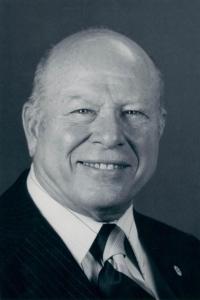Controversial Actions and Statements:
Harlon Carter
Harlon Carter (Former NRA Executive Vice President)

Harlon Carter joined the National Rifle Association at age 16 in 1930. In 1951, he joined the NRA Board of Directors and quickly rose through the ranks of the organization, serving as vice president between 1963 and 1965 and president from 1965 to 1967. After leaving the NRA presidency, Carter was appointed to a lifetime position on the NRA Executive Council. Contemporaneously with his work in NRA leadership, Carter was an employee of U.S. Border Patrol and became the head of that organization in 1950. He also worked as the commissioner of the Southwest Region for the Immigration and Naturalization Service during the 1960s. In 1975, Carter became the leader of the newly created NRA Institute of Legislative Action and is widely considered to be the leader of a movement to turn the National Rifle Association into a right-wing political organization, as opposed to an organization largely focused on hunting as it had been in the past. During the NRA’s annual convention in Cincinnati in 1977, Carter led a coup against the “Old Guard,” hunting-focused NRA leadership and took control of the organization as its executive vice president. This seizure of power is commonly referred to as the “Cincinnati Revolution.” From that point forward, the NRA adopted a hard-line, uncompromising political stance, with a focus on rolling back existing gun laws and promoting an “individual rights” interpretation of the Second Amendment.
Harlon Carter (Former NRA Executive Vice President)
On March 3, 1931, in Laredo, Texas, Carter, who was 17, shot and killed 15-year-old Ramón Casiano. After returning home from school that day, Carter was told by his mother that there were three Hispanic youths loitering near their family’s property. Carter left his house, shotgun in tow, to confront the alleged loiterers. After finding Casiano and his two companions, Carter pointed his shotgun at them and ordered them to come with him. Casiano refused and pulled out a knife and asked Carter if he would like to fight. Carter then pointed the shotgun at Casiano’s chest. Casiano pushed the gun aside and asked Carter not to shoot while taking a step back. He was then shot and killed. Carter claimed self-defense, but the presiding judge instructed the jury, “There is no evidence that defendant had any lawful authority to require deceased to go to his house for questioning, and if defendant was trying to make deceased go there for that purpose at the time of the killing, he was acting without authority of law, and the law of self-defense does not apply.” Carter was convicted of murder without malice aforethought (a crime similar to second-degree murder) and sentenced to three years in prison. Subsequently, Carter successfully appealed his conviction with the appeals court, holding that the trial court failed “to submit to the jury appropriate instructions upon the law of self-defense.” When the shooting incident was reported in media in 1981, Carter initially denied that he had killed Casiano before falsely claiming that the shooting took place on his property.
Harlon Carter (Former NRA Executive Vice President)
In 1975, Carter was asked if he would “rather allow those convicted violent felons, mentally deranged people, violently addicted to narcotics people to have guns, rather than to have the screening process?” An opponent of the 1968 Gun Control Act—which created categories of prohibited firearms purchasers—Carter responded that arming dangerous individuals was “a price we pay for freedom.”
Harlon Carter (Former NRA Executive Vice President)
In 1973, federal agents investigated Carter concerning his former employment with the Immigration and Naturalization Service after 40,000 to 50,000 rounds of government ammunition were reported missing. He was called before a grand jury to testify about the matter, but charges were never filed.
Harlon Carter (Former NRA Executive Vice President)
Speaking in opposition to legislation that aimed to ban “Saturday Night Specials” and other inexpensively-produced handguns, Carter stated in a 1972 speech before the NRA’s executive committee: “I can produce actual cases that the cheap handgun that snaps in…[a police] officer's face instead of firing has saved many, many lives, and the question arises: What are we trying to do? Upgrade the quality of handguns in the hands of our criminals?” He then promoted the use of miniature Derringer guns by children, arguing, “There was a little boy... and it was real cold and he had his hands in his overcoat. He had one of these little old derringers, and four bushy guys ambled up in an arrogant manner. He stopped them, and three of them were very nice and decent, and one of them said, ‘What would you do if I told you I had a pistol and I was going to kill you?’ And he says, ‘I would kill you, you son-of-a-bunch.’ These little guns have a very noble and a very important place and we should make our position clear.”
